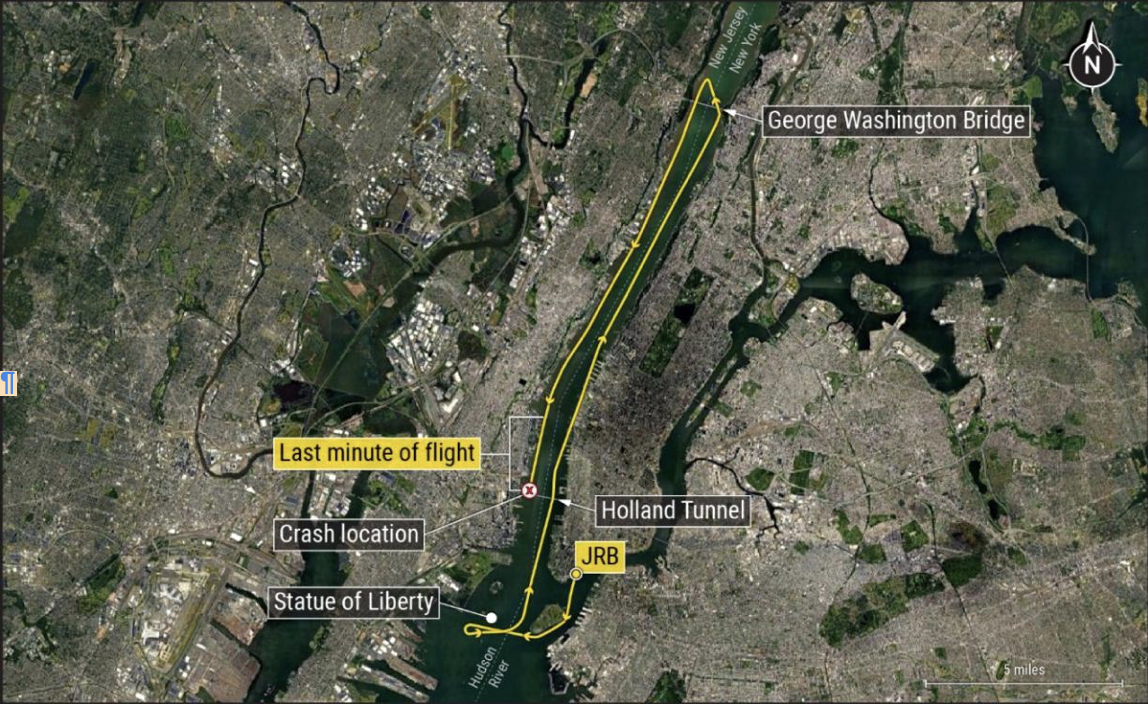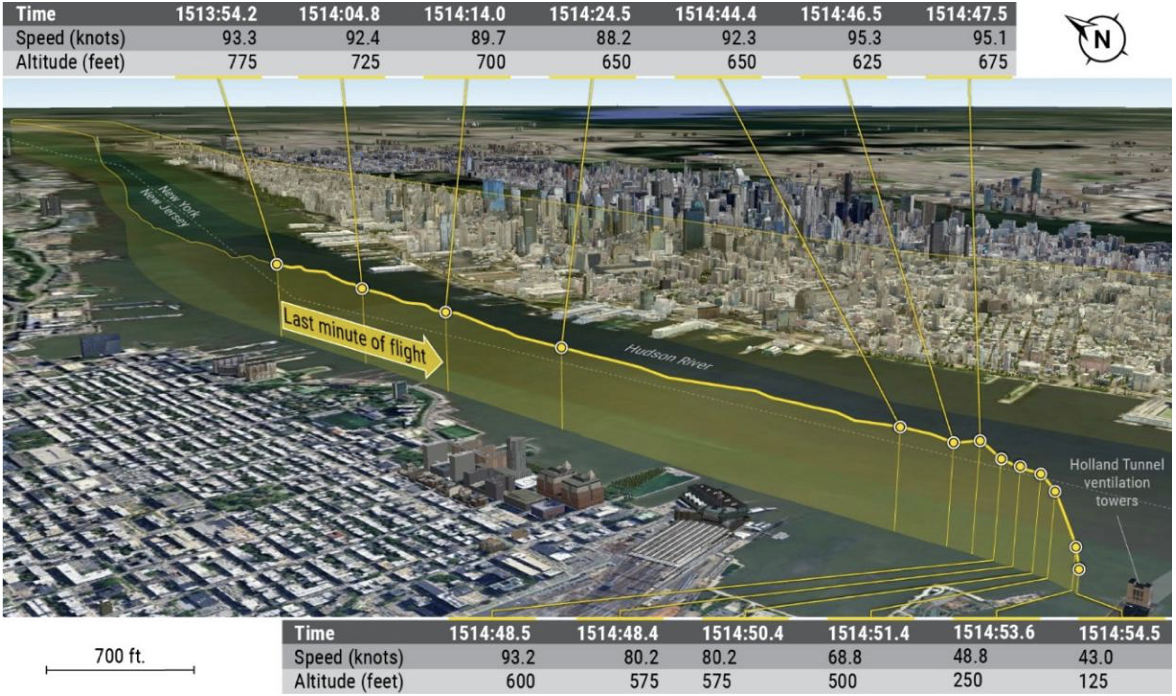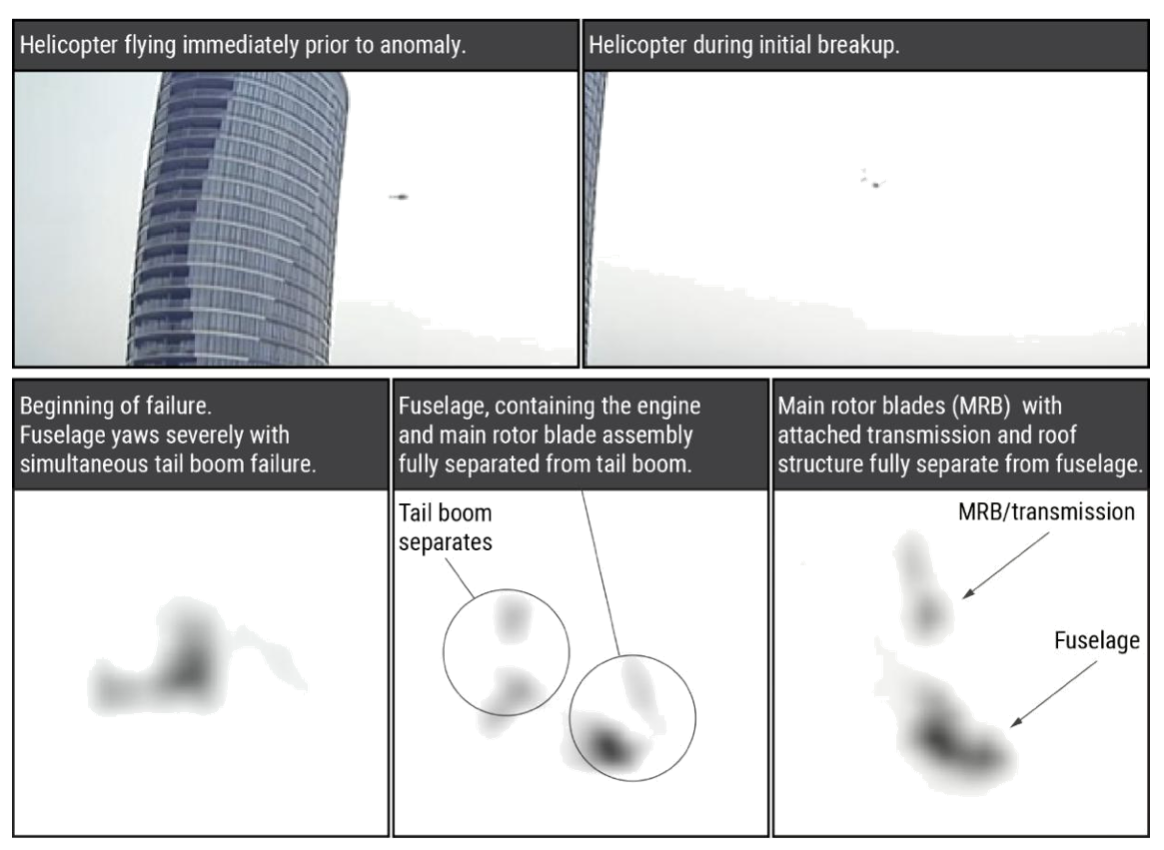NTSB Preliminary Report: Jersey City, NJ
|
Location:
|
Jersey City, NJ
|
Accident Number:
|
ERA25MA171
|
|
Date & Time:
|
April 10, 2025, 15:15 Local
|
Registration:
|
N216MH
|
|
Aircraft:
|
Bell 206L-4
|
Injuries:
|
6 Fatal
|
|
Flight Conducted Under:
|
Part 91: General aviation - Aerial observation
|
|
On April 10, 2025, about 1515 eastern daylight time, a Bell 206L-4 helicopter, N216MH, was destroyed when it was involved in an accident near Jersey City, New Jersey. The pilot and five passengers were fatally injured. The helicopter was operated as a Title 14 Code of Federal Regulations Part 91 air tour flight.
Preliminary Automatic Dependent Surveillance-Broadcast (ADS-B) flight track data obtained from the Federal Aviation Administration (FAA) revealed the helicopter departed Downtown Manhattan/Wall Street Heliport (JRB), New York, New York, about 1458. The helicopter flew a teardrop pattern south of the Statue of Liberty, then proceeded north along the east side of the Hudson River adjacent to Manhattan, past the George Washington Bridge, where it performed a u-turn, then headed south along the New Jersey side of the river (figure. 1).

Figure 1. ADS-B flight track overview of entire route of flight from takeoff through loss of signal near the accident location.
Figure 2 depicts the plot of the helicopter’s ADS-B-observed flight path for the final 1 minute of flight, with the reported time, altitude and groundspeed superimposed. As the helicopter approached the Holland Tunnel ventilation towers near Jersey City, New Jersey, it was at a geometric altitude between 625 and 650 ft. The helicopter’s altitude increased to 675 ft msl before it entered a rapid descent. The data ended at 1514:54.5 and the helicopter’s last observed altitude was 125 ft.

Figure 2. ADS-B flight track and geographic data highlighting the last minute of the flight through breakup, uncontrolled decent and loss of signal.
Several witnesses described hearing several loud “bangs” emanating from the helicopter before it broke up and descended into the river. Surveillance video (with accompanying audio) captured the helicopter traveling south before it suddenly separated into three major sections: fuselage (including the engine), main rotor system (including both main rotor blades, transmission and roof-beam structure), and the tail boom (including the tail rotor) (figure 3).

Figure 3. Enhanced surveillance video with sequential images depicting the helicopter’s flight and breakup.
The fuselage came to rest, inverted, north of the Holland Tunnel ventilation towers where the water depth was about 6 ft. The main rotor and tail boom sections were found north of the fuselage and were submerged to a depth of about 30 ft. Debris was also recovered from the surface of the river and from a rooftop near the Hoboken, New Jersey, transit building.
The helicopter was not equipped with any video or data recording devices. Photos of the pilot taken just before the helicopter departed indicated that he was wearing computer-augmented sunglasses, which had video and audio recording capability. The sunglasses were not recovered.
The pilot held a commercial pilot certificate with ratings for rotorcraft-helicopter and instrument helicopter. He held a current Federal Aviation Administration (FAA) issued first-class medical certificate, and as of March 29, 2025, had logged 790.2 total hours of flight experience, of which, 48.6 hours were in the same make and model as the accident helicopter. The pilot worked a 10 days on/10 days off schedule and the accident flight was his first day back after having 10 days off. The accident flight was the eighth tour flight of the day for the accident helicopter, and all of those flights were operated by the pilot.
Initial review of the helicopter’s maintenance records revealed the most recent inspection was an “event 2” of a progressive 300-hour inspection and 100-hour inspection conducted on February 27, 2025. At that time, the helicopter airframe accrued 12,975 total hours of operation, and the engine had accrued a total of 23,305 hours of operation. At the time of the accident, the helicopter had been operated about 50 hours since the inspection.
Day, visual meteorological conditions prevailed at JRB at the time of the accident. The surface observation taken at 1456 included broken clouds at 7,500 ft above ground level, wind from 150° at 10 knots gusting to 18 knots with variable wind between 120° and 190°, and 10 statute miles visibility. A peak wind of 36 knots from 260° was recorded at 1423.
The wreckage was recovered from the river and retained for further examination.
Aircraft and Owner/Operator Information
|
Aircraft Make:
|
Bell
|
Registration:
|
N216MH
|
|
Model/Series:
|
206L-4
|
Aircraft Category:
|
Helicopter
|
|
Amateur Built:
|
|
|
|
|
|
|
Operator:
|
On file
|
Operating Certificate(s)
|
Commuter air carrier (135)
|
|
|
|
Held:
|
|
|
|
|
Operator Designator Code:
|
NY9A
|
|
|
|
|
|
Meteorological Information and Flight Plan
|
|
|
|
|
|
|
|
|
|
|
|
|
Conditions at Accident Site:
|
VMC
|
Condition of Light:
|
|
Day
|
|
Observation Facility, Elevation:
|
KJRB,7 ft msl
|
Observation Time:
|
|
14:56 Local
|
|
Distance from Accident Site:
|
2 Nautical Miles
|
Temperature/Dew Point:
|
8°C /-2°C
|
|
Lowest Cloud Condition:
|
|
Wind Speed/Gusts, Direction:
|
10 knots / 18 knots, 150°
|
|
Lowest Ceiling:
|
Broken / 7500 ft AGL
|
Visibility:
|
|
10 miles
|
|
Altimeter Setting:
|
30.34 inches Hg
|
Type of Flight Plan Filed:
|
NONE
|
|
Departure Point:
|
New York City, NY (JRB)
|
Destination:
|
|
New York City, NY (JRB)
|
|
Wreckage and Impact Information
|
|
|
|
|
|
|
|
|
|
|
|
|
Crew Injuries:
|
1 Fatal
|
Aircraft Damage:
|
Destroyed
|
|
|
|
Passenger Injuries:
|
5 Fatal
|
Aircraft Fire:
|
None
|
|
|
|
Ground Injuries:
|
N/A
|
Aircraft Explosion:
|
None
|
|
|
|
Total Injuries:
|
6 Fatal
|
Latitude, Longitude:
|
40.728895,-74.027206 (est)
|
Administrative Information
Investigator In Charge (IIC): Read, Leah
Additional Participating Persons: Eddie Miller; FAA/AVP 110; Washington , DC
Matthew Rigsby; FAA/AVP 110; Fort Worth, TX
Jon Michael; Rolls Royce; Indianapolis, IN
Ewan Tasker; Transportation Safety Board Canada
Gary Howe; Bell Helicopter; Arlington, TX
Investigation Class: Class 2
Note: The NTSB traveled to the scene of this accident.
This information is preliminary and subject to change.
READ MORE ROTOR PRO: https://justhelicopters.com/Magazine
WATCH ROTOR PRO YOUTUBE CHANNEL: https://buff.ly/3Md0T3y
You can also find us on
Instagram - https://www.instagram.com/rotorpro1
Facebook - https://www.facebook.com/rotorpro1
Twitter - https://twitter.com/justhelicopters
LinkedIn - https://www.linkedin.com/company/rotorpro1